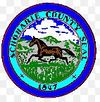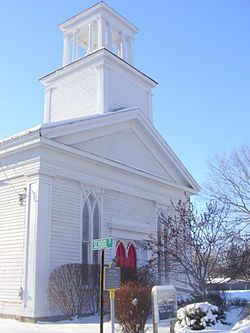Difference between revisions of "Churches"
Jump to navigation
Jump to search
JElberfeld (talk | contribs) |
|||
| (3 intermediate revisions by one other user not shown) | |||
| Line 1: | Line 1: | ||
[[File:Schoharie County Seal.jpg|100px|right|link=Gallupville|Back to Gallupville]] | [[File:Schoharie County Seal.jpg|100px|right|link=Gallupville|Back to Gallupville]] | ||
| + | [[File:Gallupville Church.jpg|300px|thumb|right|<center>'''Gallupville Evangelical Lutheran Church''' </center>]] | ||
'''Gallupville Evangelical Lutheran Church''' is a historic Evangelical Lutheran Church in Americachurch on 980 NY 443 in Gallupville, Schoharie County, New York. It is a rectangular, gable roofed, timber framed structure with narrow clapboard siding in the vernacular Greek Revival style. It was built in 1853 and a two bay, gable roofed Sunday School parish wing was added about 1964. | '''Gallupville Evangelical Lutheran Church''' is a historic Evangelical Lutheran Church in Americachurch on 980 NY 443 in Gallupville, Schoharie County, New York. It is a rectangular, gable roofed, timber framed structure with narrow clapboard siding in the vernacular Greek Revival style. It was built in 1853 and a two bay, gable roofed Sunday School parish wing was added about 1964. | ||
It was listed on the National Register of Historic Places in 2002. | It was listed on the National Register of Historic Places in 2002. | ||
| + | |||
| + | [http://en.wikipedia.org/wiki/Gallupville_Evangelical_Lutheran_Church WikiPedia] | ||
| + | *[[Dutch Reformed Church]] | ||
| + | *[[Methodist Church]] | ||
Latest revision as of 18:40, 12 March 2014
Gallupville Evangelical Lutheran Church is a historic Evangelical Lutheran Church in Americachurch on 980 NY 443 in Gallupville, Schoharie County, New York. It is a rectangular, gable roofed, timber framed structure with narrow clapboard siding in the vernacular Greek Revival style. It was built in 1853 and a two bay, gable roofed Sunday School parish wing was added about 1964.
It was listed on the National Register of Historic Places in 2002.

